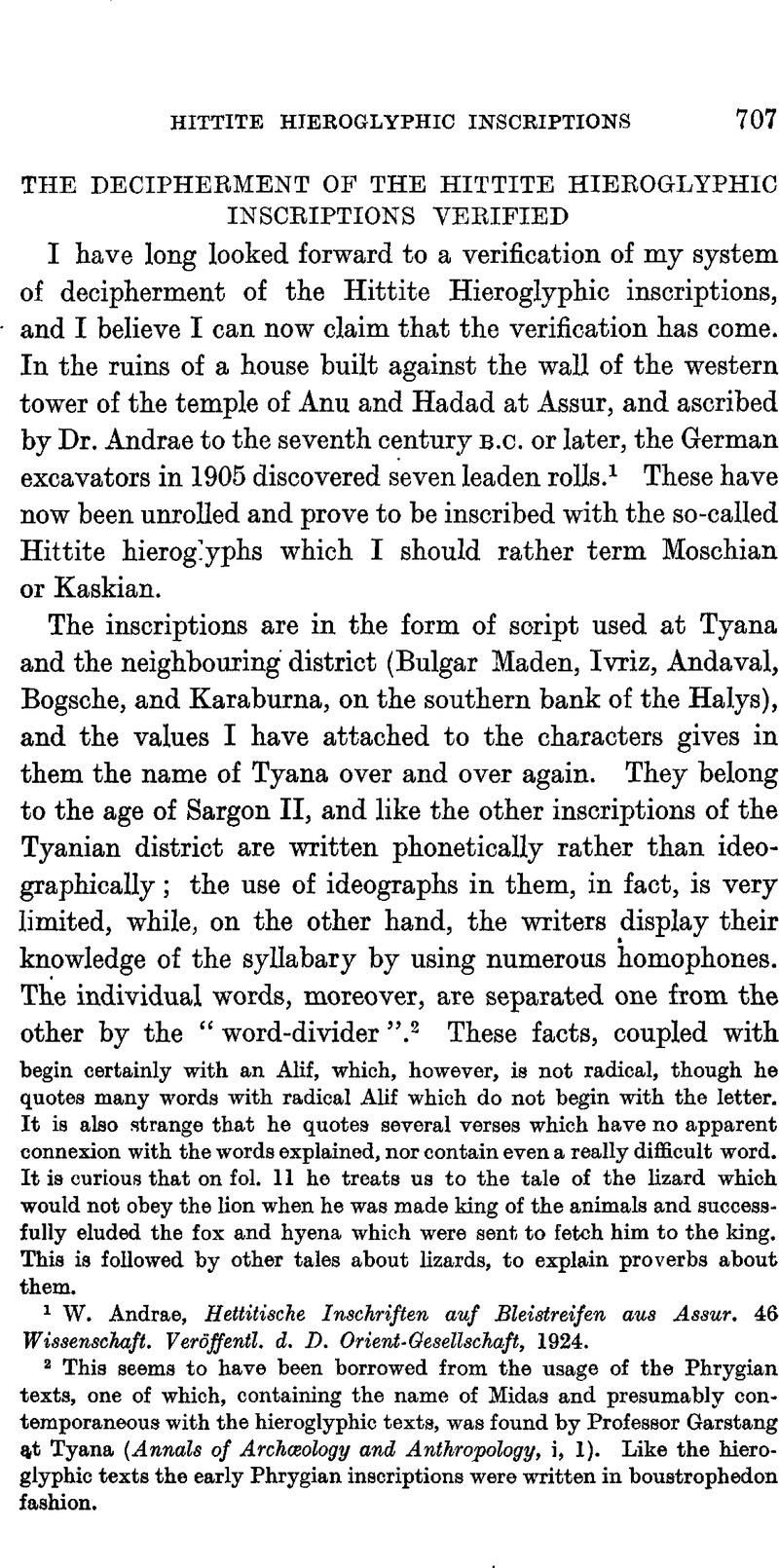No CrossRef data available.
Article contents
The Decipherment of the Hittite Hieroglyphic Inscriptions Verified
Published online by Cambridge University Press: 15 March 2011
Abstract

- Type
- Miscellaneous Communications
- Information
- Copyright
- Copyright © The Royal Asiatic Society 1925
References
page 707 note 1 W. Andrae, Hettitische Inschriften auf Bleistreifen aus Assur. 46 Wissenschaft. Veröjfentl, d. D. Orient-Gesellschaft, 1924.
page 707 note 2 This seems to have been borrowed from the usage of the Phrygian texts, one of which, containing the name of Midas and presumably contemporaneous with the hieroglyphic texts, was found by Professor Garstang at Tyana (Annals of Archceology and Anthropology, i, 1). Like the hieroglyphic texts the early Phrygian inscriptions were written in boustrophedon fashion.
page 710 note 1 Cf. the Greek σμινθος “a bath ”, the termination of which indicates its Asianic origin.
page 710 note 2 The name is written Ka-KAME-a-MIAKU(N)-kan-DET. “the sacred city of … ” in g. 4, 9.
page 710 note 3 Possibly the Sinukhta of the Assyrian inscriptions whose king Kiakki was defeated by Sargon.
page 711 note 1 The final word of the oldest of the Carchemish inscriptions (Carchemish, i, A 1, 6) is Wa-na-UANA-a-na (“the god of this city, the city-lord) of the land of Uan ”. The name is written I-na-a-nis at Aleppo and I-ni-wi-ya in an unpublished text of Carchemish, and appears as Yaêna in the Assyrian texts (W.A.I, ii, 53, 12). It is the Uan of the Egyptians west of Aleppo. See also Pinches : Proceedings S.B.A., 1881, pp. 13, 29.
page 713 note 1 In g. 4, 16, we have a-mi-i-is-mi-a Ka-na-i “the palace of Kanas ”, so the inscription may belong to Kanês. As to the Sun-god Misnas (Lydian Masanês, Masnes), Philostratos (Vit. i, 363) refers to his temple at Tyana.
The spelling of the name NINA + MISNI-Tuana-kames is interesting, since it is obviously what in cuneiform is called a “rebus-form ”. Fifteen years ago I showed that tua meant “two ”, and uana, ana, “god ”. And now comes the verification !
page 714 note 1 In the Bulgar Maden inscription (Mess. 32, 5) mention is made of “the god of N(a)-ka-tua-ka-mi-s”, “the fortress of Năkat(u)a ”. Is this the (hitherto unknown) older name of Nigdeh ?
page 715 note 1 The boot, MI, signifying “earth ”, “land ”, seems to have had a value yi, wi. At all events it is sometimes omitted before the suffix -i-, Tarku-is, for instance, being written instead of Tarku-MI-is.
page 715 note 2 Tarkamos (T-r-k-m-u) was a governor of Cilicia under the Persians whose name was first read upon roins by Six. Sundwall quotes the Greek forms Ταρκομως, Ταρκιμως, and Τροκομμας.
page 715 note 3 The name of Kanis also occurs on the Obelisk of Izgin (Mess. 19, B. 16), mê-a Ka-ana-n(a)-is “belonging to the city of Kanas ”.


